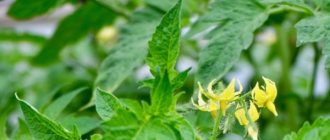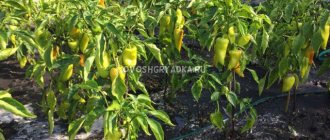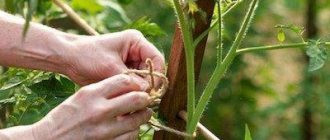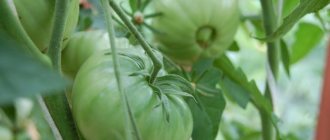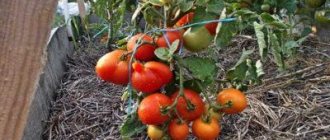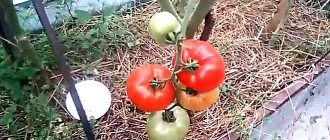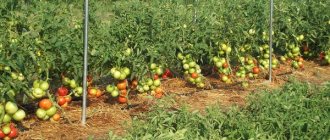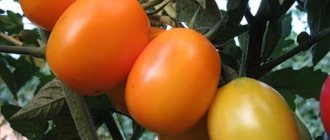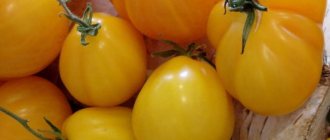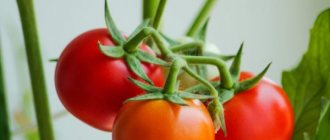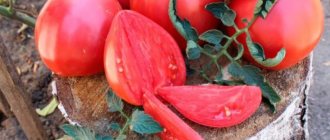If you are planning to plant tomatoes in your garden, but you don’t have enough free space, then you need hanging tomatoes. They can be grown even at home. These varieties will allow you to significantly save space and get the desired harvest.
Buckets, various containers or hanging pots are suitable for growing. Tomatoes can be grown at home right on the windowsill. Caring for them is quite simple and can be done even by a beginner in gardening.
In addition to juiciness, tomato fruits have the following advantages over other crops:
- Firstly, they can be planted much earlier than seedlings for a greenhouse or garden. This is all about caring for the plant.
- Secondly, you can enjoy the taste of tomatoes all year long if you grow them at home on your windowsill.
- Thirdly, ampel varieties of tomatoes are less likely to be infected with diseases, since the soil in which they grow is constantly ventilated and saturated with oxygen.
Tomato amulet characteristics and description of the variety!
The “Obereg” tomato quickly became popular among those gardeners who prefer to plant early-ripening varieties. This vegetable with a characteristic yellow color pleases everyone with its incredible taste, juiciness, and abundant harvest, which is guaranteed to everyone who approaches the cultivation of Amulet as responsibly as possible. The Amulet does not require special care.
It is only important to adhere to general recommendations for caring for early ripening varieties. You can harvest the fruits of “Obereg” soon after planting the seedlings in the ground
The vegetable has a short growing season. This is the best variety for food purposes.
You can read a description of the “Obereg” tomato, its characteristics, productivity and reviews from experienced farmers in this article.
Description and characteristics of the variety
Amulet belongs to the group of early-ripening determinate varieties, the bushes of which are characterized by short stature. Farmers fell in love with the amulet because it is guaranteed to produce a large harvest and caring for tomato bushes is simple.
In open ground, Amulet feels comfortable, but even in greenhouse conditions, gardeners can achieve an excellent harvest. The height of the bush reaches almost half a meter.
Unlike some other early ripening varieties, Obereg will not require pinching.
- The surface of the fruit is smooth and the walls are dense, while the juiciness of the tomato is maintained at a high level.
- The density of the walls guarantees excellent resistance to mechanical damage that is possible during transportation.
- The variety is not intended for sale, but many gardeners manage to successfully sell the fruits on the market due to their excellent presentation.
- When the stage of biological maturity of the fruit arrives, tomatoes acquire a rich yellow color. Some farmers characterize it as golden.
- On average, the weight of one fruit is 60 grams, but with good fertilizer and treatment of the bushes, it is possible to grow fruits weighing 80 grams. weight.
- Fresh Obereg tomatoes are often used in salads.
- “Amulet”, judging by the reviews, is excellent for preservation.
- The plant has become popular in Moldova and Russia, as well as in Ukraine.
Advantages and disadvantages
The Amulet will not be stored for a long time. If the gardener has the opportunity, he collects the fruits earlier and places them for ripening. But after the fruits reach technical maturity, tomatoes must be consumed within the next two weeks. The variety has good resistance to negative factors, including frost.
However, gardeners recommend protecting the bushes at night during this time by covering them with film. The obvious advantages include the incredible taste of the fruit and their ideal structure and wall density. The variety is loved due to the resistance of the fruit to cracking when it comes time for frequent rains or unbalanced watering by the gardener.
Growing
In mid-April you can start growing seedlings in cool regions.
In the south, you can start growing much earlier, so that after 65 days you can transfer well-formed seedlings to open ground. You can do this in early May.
Some gardeners, under favorable climatic conditions, manage to safely plant seedlings at the end of April. The main thing is that the soil has been previously fertilized and well loosened.
When planting a plant in the ground too early, when there is still a chance of frost, the tomato is hilled up and protected overnight with film
It is important to adhere to a 70 x 40 cm planting system to achieve maximum yield.
One square meter of land should have from six to eight bushes.
In such conditions, the low-growing “Amulet”, whose branches can be spreading, will have enough space to form a large number of fruits and their unhindered development.
To prevent the plant from suffering from possible attacks by pests, the seed material before growing seedlings is well treated with potassium permanganate or another disinfectant, which guarantees the formation of a protective shell. Although “Obereg,” according to the characteristics of the variety, tolerates many threats from pathogens, additional protection would not hurt.
Gardeners do not recommend rushing to plant young seedlings in the ground if six true leaves have not yet been formed on it. The row spacing should be within 70 cm. Such cultivation will help minimize the manifestation of late blight.
Diseases and pests
| Blackleg Ways to fight:
| |
| Medvedka Ways to fight:
| |
| Whitefly Ways to fight:
|
Description of the tomato variety Ampel mixture, features of cultivation and care
Ampelous tomato mixtures are an excellent alternative for those who do not have the opportunity to grow vegetables in the country or do not like long-term work on caring for garden plants. Such varieties allow you to get tomatoes without chemicals, which will delight you not only with their appearance, but also with their taste.
The horticultural market today offers a wide variety of species that can be grown in flowerpots or boxes. Mini-varieties can be grown not only outdoors, but also indoors.
Advantages of varieties
Varieties of hanging tomatoes have a number of undeniable advantages over traditional varieties of tomatoes. The main advantages of planting such garden crops include the following:
- tomatoes can grow in heavy shade;
- are not afraid of drafts;
- do not have a tendency to stretch;
- due to the fact that the plant does not come into contact with the ground, the risk of disease and pest damage is minimized;
- a wide variety of varieties.
Reviews from gardeners indicate that, despite the small size of the fruits of ampelous varieties, they are often superior in taste to varieties of traditional crops. Today, the horticultural market offers a large assortment of mini tomatoes, differing in shape, color, taste, and shoot formation.
What varieties are popular?
Among the wide variety of hanging varieties, gardeners annually select the most impressive ones and compile a rating. Traditionally, the following cultures are among the leaders:
- Garden pearl.
- Citizen F1.
- Cascade.
- Brindle.
The ampelous Garden Pearl reaches a height of no more than 40 cm. The plant is an early ripening crop. The first fruits are harvested 93 days after the first shoots appear.
The culture produces small, neat pink tomatoes, the weight of which varies from 15 to 20 grams. It is not difficult to grow such mini-tomatoes, since the advantage of the variety is that it is undemanding to growing conditions and there is no need for pinching.
The only requirement is that the growing container must be at least 3 liters in volume.
The advantage of the hanging variety Gorozhanin F1 is its early ripening and high yields. The average height of the bushes reaches 80 cm. The plant produces bright red fruits with an average weight of 30 to 50 grams. Unlike most hanging tomatoes, the variety requires pinching and the growing container must have a volume of at least 4 liters.
The Cascade variety is presented in two varieties: Yellow f1 and Red f1. The first fruits are obtained after 100-110 days. A special feature of this variety is the ability to form long shoots up to 1 to 1.5 meters in size.
The plant produces yellow or red vegetables with an average weight of 40 to 60 grams. The volume of flowerpots for this type should be at least 5 liters. It is not recommended to remove the stems of the plant, otherwise the yield will decrease.
Only yellow or dried leaves are removed.
The average height of the shoots is 15 cm. Abundant greenery perfectly protects the soil from excessive evaporation, so the plant does not need frequent watering.
Nuances of cultivation
Immediately before sowing, the seeds of ampelous tomatoes are placed in a weak solution of potassium permanganate for 60 minutes and then washed with running water. Sowing is carried out in small depressions, which must be made no more than 2 cm. The recommended sowing time is the beginning of March; sowing during this period will allow you to get an early harvest.
If you make your own soil, it should consist of humus, peat, and turf. A container volume for planting of 5 liters is considered the most suitable. Ampelous tomatoes are afraid of stagnant moisture, so a 2 cm drainage layer is formed at the bottom of the pot.
Diving is carried out after the appearance of 2 leaves. Plants are taken outside in May if there is no threat of frost. When transplanting, the plant is buried 3 cm lower compared to the level of previous growth.
Experienced gardeners talk about 2 golden rules for growing hanging varieties. The first is the need to periodically shake the plant when growing indoors. The second is related to feeding every 14 days.
Complex fertilizer is applied to the soil in an amount of 5 grams for every 1 kg of soil.
City dweller F1
There are two options for growing this variety: as a standard hanging plant or with a garter. In the second case, it will be a compact bush with erect shoots. It is important to know that City dweller F1 is quite large, so for normal development of the root system a container of at least 4 liters is needed. In order for the fruit to set as quickly as possible, the stepsons should be removed. If you continue to form the shoots, you can get a plant that will be covered with a huge number of large tomatoes of a juicy red color. They will delight you with their pleasant taste and bright appearance.
Related article:
Tomato diseases and measures to combat them
Popular varieties
Producers pay much more attention to productive varieties compared to ornamental varieties. The assortment of specialized stores offers a small selection of seeds intended for cultivation in hanging pots. Let us dwell on the most common varieties and a description of their characteristics.
Garden pearl. Despite the name, the variety is suitable not only for home cultivation, but also for open ground. The compact size of the bushes (20-40 cm) and root system allows the use of a container with a volume of 3-5 liters. Creeping, branched shoots produce 300-500 pearl-pink tomatoes per season. The small size (15-20 g) is compensated by the pleasant sweet taste of tomatoes.
Ripe fruits are used for canning, decorating dishes and as a vitamin-rich snack. The variety does not require pinching; the harvest begins to ripen in 80-90 days. With proper agricultural technology, it continues to form ovaries until the onset of cold weather. In an apartment, harvesting can take several months. This requires regular fertilizing and a soil volume of at least 5-6 liters.
Citizen F1. An early hybrid, bred specifically for growing on city balconies and window sills. The stems grow up to 50-60 cm, so the optimal size of the growing container is 5-7 liters. Falling tassels produce bright red tomatoes weighing up to 30 g. The first harvest can be harvested after 3-3.5 months. The rate of maturation is influenced by the number of stepsons. The more lateral shoots there are on the bush, the later the fruits ripen.
The taste of ripe tomatoes is suitable for fresh consumption. The thick skin protects against cracking during heat treatment, so miniature tomatoes can be used for whole-fruit canning. The hybrid is resistant to diseases and is not afraid of drafts.
Cascade F1. An ampelous hybrid of tomatoes with drooping shoots. Up to 30 scarlet tomatoes are formed on one brush. There is a variety with yellow fruits (Cascade Yellow F1). It is distinguished by long stems reaching 100-120 cm, so the bushes should be placed at the appropriate height. Does not need to remove stepsons. Grows a branched bush strewn with fruit clusters.
It is recommended to grow the hybrid in hanging pots with a volume of 5 liters or more. A heavy bowl requires reliable fastening or a high pedestal. To increase productivity, it is necessary to feed the bushes at least 3 times per season.
Tumbling Tom Red F1. A variety of early ripening ampelous tomato for growing in the garden or on the balcony. The height of the bushes is 20-25 cm, while the length of the stems with fruit clusters hanging down is about a meter. The size of the plant differs depending on the size of the container. The minimum pot volume is 2.5 liters. You can enjoy sweet, red cherries after 2.5 months. The hybrid does not require formation, support and removal of stepsons. A prerequisite for growing is fertilizing and frequent watering.
Some gardeners prefer to plant ornamental varieties with flower crops together. As you can see in the photo, this method of growing becomes a real decoration of the site.
Mascot. An ampelous tomato variety, which is most common in our country. It grows in the garden and on the balcony, showing resistance to temperature fluctuations and drought. The first ripe tomatoes, weighing 15-20 g, begin to ripen after 90 days. Like all ampel varieties, it bears fruit for a long time.
Bushes up to half a meter high are covered with a scattering of red, slightly elongated tomatoes. Can be grown in open ground. One of the advantages is immunity to blossom end rot and late blight. The thick skin allows the tomatoes to remain intact during canning.
The ampel mixture of varieties from the company Aelita is popular among gardeners. The package contains planting material of the Thumbelina (red-fruited) and Vodopad (yellow-fruited) varieties. Sweet, aromatic cherries, intended for greenhouses, balconies and growing on windowsills.
Is it worth growing: advantages and disadvantages
Those gardeners who grow standard tall varieties in open ground and greenhouses may ask a reasonable question: what is the point of growing hanging varieties? After all, their yield is less than that of classic tomatoes, but they require more fertilizer, since they grow in a limited pot volume.
Advantages of hanging tomato varieties:
- Ampelous tomatoes are beautiful . The decorative function of these plants is used very often. If the owner of the plot gardens not only for food, but also wants to see his property aesthetically designed, then hanging varieties are what he needs. After all, beds with vegetables and other crops are the most unpresentable and boring element of the landscape; here you need to try to make it original. And massive flower pots with cascading tomato bushes can be placed in different places and at the same time enliven the landscape. Parapets, semi-columns, cabinets, cornices, and finally, all sorts of hanging options for walls, roofs and crossbars - this is not a complete list of places that can be perfectly decorated with the help of hanging nightshades.
- Mobility . There are many difficulties when growing in open ground above the southern latitudes of Russia. Sunny weather may give way to frost or strong winds. It is almost impossible to protect tomatoes in garden beds from natural phenomena. But the pots with the crop can be temporarily brought into the house, onto the veranda or even into the barn. Plus, you can easily regulate the amount of water supplied to your plants, regardless of whether rain is expected or not.
- Potted trailing varieties can be grown even by those who do not have a summer cottage, thanks to growing in pots. This can be done on the balcony. and with careful care - even in the room. Of course, you won’t be able to enjoy tomatoes in large quantities. But adding variety to the menu and getting the effect of novelty is not a problem. In addition, a few plants will receive much more attention than extensive beds.
- Plants are much less susceptible to fungal, viral and bacterial diseases , thanks to growing in a closed pot with treated soil or purchased specialized soil mixture. It is much easier to combat pests - those that live in the soil simply will not reach the roots and shoots, it will be difficult for crawling ones to climb into a hanging plant pot, but it is much easier to fight against flying ones.
Alina
36 years old, Chelyabinsk
I've always wanted to grow tomatoes. But we live in an apartment on the 16th floor. When I found out about ampel tomatoes on the Internet, I decided to try it. I sow the seedlings in cups on the windowsill, in May I transplant them into flower pots and hang them on the loggia. The windows are almost always open. The smell is amazing, and at the end of July I already start picking tomatoes - there are a lot of them.
— Alina 36 years old, Chelyabinsk
Ampelous tomatoes - cultivation
Ampelous fruits are usually smaller in size than ordinary ones from the garden, but they taste much better. Such tomatoes do not need a lot of sunny color, so you can keep pots of seedlings in semi-darkness. You can plant them in boxes in an apartment a little earlier than in open ground.
The only drawback is the small amount of harvested crop.
Tomatoes in pots decorate any room
Important! Diseases and pests bother plants in hanging pots less often than in open ground
The main rules for planting ampelous tomatoes
To harvest a rich harvest of ampel tomatoes, first of all, you need to choose good seeds. The quality and quantity of the harvest depends on the selected variety and proper care.
Breeders are growing new varieties
Containers for growing ampelous tomatoes should have a volume of no more than 3-5 liters; a two-centimeter drainage layer should be made at the bottom.
Sowing ampelous tomato seeds in pots
Before sowing seeds in containers, they must first be soaked in potassium permanganate dissolved in water, then washed with warm water and planted to a depth of 2-3 cm.
In specialized stores you can purchase seeds in the form of granules. In addition to seeds, granules contain microelements and pesticides necessary for the rapid growth and development of plants. They have already been treated by manufacturers against various diseases and pests, so they do not need to be soaked in potassium permanganate.
Advice! To check the quality of the seeds, you need to soak them in warm water for a few minutes. Seeds that float to the top should be thrown away, as they are empty and will not germinate.
Selected seeds should be placed on a wet cloth or gauze for 5-7 days so that they have time to germinate. As the fabric dries, you need to add a little water. When the sprouts reach a height of 5-6 cm, they need to be carefully planted in moist soil.
Suitable soil for tomatoes is a mixture of three components 1:1:1:
- turf;
- humus;
- peat.
After several leaves appear, the tomatoes can be planted in separate pots. During replanting, you need to fertilize with mineral fertilizers. Together with the plant, you need to take a lump of the previous soil and place it in a new container. It needs to be planted 1 cm deeper than it was before. This will help the sprouts gain a foothold in their new location and send out new roots.
Features of planting seedlings
When buying ready-made seedlings, you need to adhere to the same rules as when sowing seeds. Seedlings should be planted in mid-to-late May in hanging containers. In warm sunny weather they can be hung outside; on cold days, especially at night, it is better to keep them indoors.
With proper care for hanging tomatoes, you can expect a rich harvest.
Important! When the soil in the pot sags a little, you should add new soil. The lower leaves need to be removed from time to time
Caring for ampelous tomato seedlings
When the plant reaches a certain size, it should be pinched. But there is no need to cut off all the stepson stems; especially the lower ones are distinguished by their ability to bloom and bear fruit profusely. The formation of not one, but several stems on a plant makes the bush beautiful and lush.
Hanging pot is a great decoration
To grow a rich harvest of tomatoes on the windowsill, you should water them regularly - once a day, in the morning or in the evening. Fertilizing of hanging tomatoes should be done once every 10-14 days.
Cascade Elo F1
Another tomato variety grown in the same way as hanging flowers. Its shoots fall down to half a meter. There is no need to tie up the branches, as they will still bend under the weight of the bunches.
This variety will appeal to those who like tomatoes of non-standard colors, since this variety is light yellow. It blooms actively several times a season, and there is no need to plant it, which makes care very easy. The only important note: for good development of the ground part, you need a container with a volume of 5-8 liters.
Related article:
How to plant overgrown tomato seedlings
Agricultural technology for growing tomatoes
Sowing seeds for seedlings is carried out in March. They are planted to a depth of 2 cm. Before planting in the ground, the seeds are treated with an aqueous solution of potassium permanganate.
The soil for planting is prepared from the following components:
- peat – 1 part;
- turf soil - 1 part;
- humus.
The soil mixture should be loose, light in mechanical composition, and easily allow air and moisture to pass through. You can increase the nutritional value of the soil by adding wood ash and superphosphate. Components are added 1 tsp. per 10 kg of mixture.
Watering the seedlings is carried out carefully using a spray bottle
It is important to avoid waterlogging of the soil, which can cause plants to become infected with blackleg disease.
For normal development of seedlings, it is necessary to fertilize using small doses of complex fertilizer. At the stage of formation of 2 true leaves, plants are planted in separate containers.
Seedlings of hanging tomatoes are transferred in May with a lump of earth. The seedling is planted 3-4 cm below the level at which it grew before replanting. Containers with bushes of ampelous tomatoes can be placed on the site, in the room, or placed on the balcony on a high stand.
The main thing is to place the containers so as to provide free access to the plant for watering and care. For 1 bush of ampelous tomato, it is recommended to use a container with a volume of 3 liters. To get the highest yield from the bush, you need pots with a volume of 4-5 liters.
Sowing ampelous tomatoes
Tomatoes should be sown for seedlings in March. To disinfect the seeds, it is recommended to keep them for about an hour in a pale pink solution of potassium permanganate. After this, they need to be washed in clean water and sown in a seedling box.
Sow the seeds of ampelous tomatoes to a depth of no more than 3 cm
To sow such tomatoes, you can use ordinary universal soil for growing vegetable seedlings. But if you prefer to make your own substrates, you can mix peat, turf soil and humus in equal proportions. The soil for growing hanging tomatoes should be loose and light, well permeable to water and air.
Seeds of ampelous tomatoes for seedlings are usually sown in March, planted to a depth of 2-3 cm. Before sowing, they are soaked for an hour in a weak solution of potassium permanganate, and then washed in clean water. The soil is made up of equal parts of peat, turf soil and humus. The substrate is prepared so that it is loose, air- and water-permeable, and light in mechanical composition. You can increase the nutritional value of the soil by adding 1 tbsp. wood ash and 1 tsp. superphosphate and potassium sulfate (per 10 kg of mixture).
Rating of the best
Universal
- “Salting Miracle” is a universal, determinate variety, intended for cultivation in open and protected ground. The plant grows up to 50 cm. Resistant to viral and fungal diseases. The fruits are bright red, weighing up to 90 grams. Ripening period is from 80 to 90 days.
- "Sanka" is an ultra-early ripening variety. Harvesting begins on days 73-75. “Sanka” is resistant to low temperatures, diseases and pests. It is not demanding on lighting; short daylight hours are sufficient for fruit ripening.
- “Room Surprise” is a high-yielding, low-growing, determinate variety of tomatoes. Can be grown as a houseplant. The height of the bush is no more than 50 cm. The fruits weigh up to 25 grams, the pulp is juicy with sourness. You can harvest up to 2 kg of tomatoes from one plant.
- “Moscow Stars” F1 is a super early hybrid that grows equally well in greenhouses and open areas. It takes root quickly and bears fruit abundantly. The plant is determinate. The bush grows up to 60 cm. Ripe fruits weigh just over 100 grams. collected in brushes of 15-20 pieces. Harvest begins after 80 days.
- "Debut" F1. The height of the determinate hybrid is up to 75 cm. It is resistant to diseases and tolerates drops and temperature changes well. Harvest ripening period is 3 months after sowing the seeds. Average fruit weight – 220 g.
For growing in greenhouses
- “Big Momma” - a plant with a powerful, strong stem requires a garter, otherwise the fruits will lie on the ground. The ripening period of the first fruits is no more than 85 days. Productivity reaches 10 kg per 1 sq.m. Resistant to powdery mildew and late blight.
- "President II" F1 is a semi-determinate plant. The height of the trunk is more than two meters. Harvesting begins after 75-80 days. 8-10 ovaries are formed on one hand, the average weight of one fruit is 300 grams. Excellent taste, dense, juicy pulp allow the crop to be used for making juice, puree, and tomato paste. The fruits are salted, pickled, and consumed fresh.
- "Alenka" F1 is a hybrid, determinate variety. Harvest ripening period is 90 days. Characteristics: early ripening, disease resistant, productive, has excellent fruit quality.
- "The Pride of Siberia" The variety is large-fruited, the weight of individual specimens reaches 750 g. The first fruits ripen on the 85th day. “Pride of Siberia” has good taste characteristics and is used for making juices and tomato paste. Due to their large size, the fruits are not suitable for canning.
- "Blagovest" F1 is an early-ripening, high-yielding tomato variety. The fruits ripen on day 95 and are bright red in color. The average fruit weight is 110 g. The bush grows up to 1.8 m in length and requires mandatory support. To increase the yield, the plant is formed into two trunks.
For growing in open ground
- "Aphrodite" F1 is a super early variety. The ripening period of tomatoes is 70 days. Dense, fleshy fruits weigh 150 - 170 g. Well transported and stored. They are universal in use: tasty fresh, suitable for canning.
- "Don Juan". Fruit ripening period is 90 days. Tomatoes are elongated in shape with a sharp end, raspberry-red with longitudinal yellowish stripes. A distinctive feature of the variety is its quality characteristics: the fruits are well stored for a long time.
- “Golden Stream” is an ultra-early ripening variety, the harvest ripening period is 80-85 days. The variety is of determinate type, grows up to 70 cm. The fruits are golden-yellow in color, retain freshness for a long time, and are easily transported. They are used in making juice, canned and consumed fresh.
- "Bullfinch" is a determinate miniature plant. The height of the bush does not exceed 40 cm. Tomatoes ripen in 75 days. The shape of the fruit is rounded-flattened, slightly ribbed. Color – red. Plants can be grown on balconies.
- “Labrador” is a determinate plant, 60-70 cm high. The fruits ripen on the 75th day, weigh 100-150 grams, up to three kilograms of tomatoes are harvested from one plant. The variety is ultra-early, resistant to all types of diseases, unpretentious, the crop ripens evenly, has good shelf life, and is universal in use.
There are a huge number of super early tomatoes. Breeders annually offer new, improved, zoned varieties. Today you can choose any one for a greenhouse or open ground.
Caring for tomatoes
The process of growing seedlings is very simple and is no different from that focused on planting in the ground.
- The most delicate point is drawing up the correct soil mixture.
There are several options here, either use already tested soil, or mix humus and black soil in a 2:1 ratio.
Of course, you can experiment with filling your flowerpot, but our recommendations are guaranteed to work successfully in practice.
- Tomatoes need to be watered regularly, according to a specific schedule. For tomatoes growing outside, 70 ml of warm, purified water will be enough.
If the tomatoes are on the balcony, pour out 50 ml, and for indoor tomatoes, 40 ml is enough. In the summer heat, it is customary to duplicate watering in the evening, but with a halved amount of water.
- Soil care includes hilling every 4 days; more often it is not necessary, since excessive attention to the soil can interfere with moisture absorption.
- There are no specific rules regarding feeding; the main thing is to know when to stop and not to overdo it. The right solution would be to fertilize tomatoes in liquid form once a week.
You are free to purchase special food or make your own, for example:
- 1 mg urea;
- 1g potassium sulfate;
- 5g superphosphate.
The proportions are calculated for 1 liter of water, an excellent and affordable fertilizer.
- Cow dung, 1 part.
- Water, 5 parts.
Natural ingredients will have a positive effect on your plants.
- Bird droppings, part 1.
- Water, 15 parts.
Everything is the same as the previous recipe.
- Forming bushes
This is called pinching and this procedure helps specific varieties to grow correctly and actively develop.
In the process of pinching tomatoes, you remove weak shoots, tear off drying leaves and form a tomato bush in every possible way. Stepping is very simple; even a beginner can handle it.
Description and characteristics of the variety
Description of the bush
Tiger tomato forms bushes up to 1.5 meters. The erect stems branch well and form medium-sized foliage. Fast-growing shoots are pinched to stop the growth of green mass. Then more nutrients will be spent on fruit ripening.
Long stems are fixed to a trellis or other support. To obtain maximum yield, it is advisable to form 2-3 stems, removing the stepsons.
Description of fruits
Interest in the variety arose due to its unusual colors. Small, round, red tomatoes with yellow stripes, reminiscent of the color of a tiger. The skin is dense, its integrity is preserved during ripening. Tomatoes hold tightly and rarely fall off their stems. The pulp is juicy and fleshy. The taste is sweetish, with a slight sourness.
The variety is mid-season. The period from sowing seeds to the first harvest is 110–120 days. The first group of ovaries is formed at the level of 4–5 permanent leaves.
The next inflorescence is formed after 2–3 leaves. A group of flowers forms a brush, where 4–6 ovaries ripen. Each tomato weighs 30–50 grams. 6–7 tassels grow on one stem.
